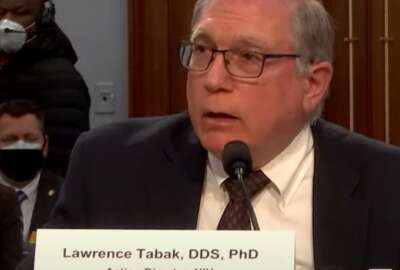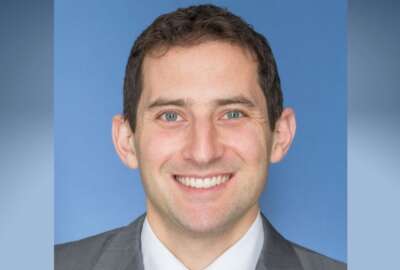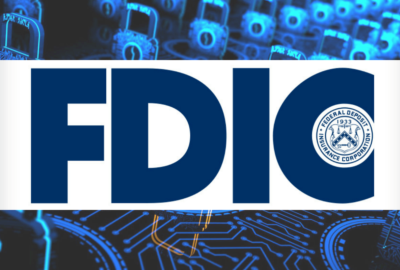
Hubbard Radio Washington DC, LLC. All rights reserved. This website is not intended for users located within the European Economic Area.
Hubbard Radio Washington DC, LLC. All rights reserved. This website is not intended for users located within the European Economic Area.
After a long stint as the deputy director of the center for information technology at the NIH, Stacie Alboum is about to head to the Federal Deposit Insurance C...
Best listening experience is on Chrome, Firefox or Safari. Subscribe to Federal Drive’s daily audio interviews on Apple Podcasts or PodcastOne.
After a long stint as the deputy director of the center for information technology at the NIH, Stacie Alboum is about to head to the Federal Deposit Insurance Corporation. At the ACT-IAC emerging technology conference in Cambridge, Maryland earlier this week, Federal Drive with Tom Temin caught up with Alboum to discuss what her new job will be all about.
Interview transcript:
Stacie Alboum: I’ll be joining the CIO organization as the Deputy Director for enterprise strategy.
Tom Temin: What does that mean, enterprise strategy? Enterprise IT strategy? Or what should the FDIC do for a living?
Stacie Alboum: So the FDIC has quite an impressive IT operation over there. And I’m going over there, one of the big things I’ll be doing is leading the development of the next IT strategic plan. And working with the IT leadership team there under Sylvia Burns’ leadership, of course, to modernize the IT infrastructure and architecture. And what I’m most excited about, the role that I’ll get to play in this new position is engaging and partnering with the programs across the agency. So getting to learn about their business, and more about the mission, and ensuring that IT is being responsive to their needs and fulfilling them. And obviously, I’ve been very fortunate to support so many incredible missions across the federal government over the last two decades. This is my fifth agency, and I’m going from spending the last 15 years supporting science missions. So protecting people’s health, to going to more of the financial industry. But personally, maintaining the stability in the public confidence in the nation’s financial system is a pretty important job. And I’m just really honored to join the FDIC family be a part of it.
Tom Temin: And you mentioned unifying the missions there through the network. And you did that at NIH, to some extent, all of the different components of NIH, I think there’s what a couple of dozen different components within NIH, the different Institutes and there was a construction, a deliberate way of tying them together with a single network. Maybe review that for us, where does that all stand now? Is it done? Or is it still evolving?
Stacie Alboum: The network is one of the most critical set of capabilities that we’ve been delivering at NIH’s center for IT. As you’ve heard, we’re so dependent on that with the massive amounts of data that we generate. And so when I joined NIH in 2017, we were in the midst of modernizing our network. And so we completed that around, let’s say, 2018, 2019, and stabilized. And believe it or not, we’re now embarking on the next generation of our network capabilities. And so one of the things I love about NIH is it’s really a community. So although the way it’s organized and operates is highly federated, we really come together as a community. So we’re currently partnering with the other institutes and centers and with industry to formulate our vision for the future of the network.
Tom Temin: And what did you learn from that effort that might carry you into FDIC?
Stacie Alboum: Well, something that’s quite pertinent and will play into my role, which is the importance of understanding the business, bridging technology to the business, spending time establishing those partnerships with people all over the agency, and really collaborating them and co-creating solutions with them. Embedding IT into the business. And so I learned a lot about that at NIH. And I’m excited to do the same at FDIC.
Tom Temin: And the purpose of a network, of course, is to move data.
Stacie Alboum: Six petabytes at our agency.
Tom Temin: Right. And that’s something that couldn’t have been imagined 20 years ago, or 40 years ago, when this whole IT thing started in the government. So what are your data learning is what do people need to know about data in this age, when you move six petabytes a day?
Stacie Alboum: Well, it’s interesting, because we’ve always done a lot in the labs and what our network has really done is interconnected all of those facilities and given us the ability to share datas and store and manage it in ways we never could before. And the network is certainly at the core of that. But what we’ve been doing recently through our strides program, is moving large research datasets out to our cloud platforms. And I don’t know that we could have imagined that even five years ago. And so I think the biggest learning when it comes to data is just to is that the landscape is always shifting datas always going to be at the heart of what we do and all of our programs, but the world around us is changing and we have to constantly be, you know, kind of watching where the world is going and shifting with it and not be afraid to take the next leap.
Tom Temin: And you have been kind of a pioneer in or at least a advancer of the idea of what you call mission excursions. Tell us what Those were at NIH, and is it something you plan to do at FDIC?
Stacie Alboum: Yeah. And I imagine Sylvia has probably already got a head start on that at FDIC. So I’m excited to go there. She’s already been leading the IT organization for several years. But when I came to NIH, you know, we have an incredible mission, and really talented, dedicated workforce, I call those things together, kind of the secret sauce of any incredible work experience. But what I noticed is that some of our we have a very diverse IT workforce. And some of our newer employees hadn’t had a chance to really engage with the broader NIH community, and learn about the broader mission. At the same time, we had many talented individuals that had worked at NIH for years, decades even, and maybe had at some point become, you know, disengaged or more removed from that. So it was part of our program, most people would call it employee engagement, I call it improving the employees experience. Because our employees are engaged. And it’s our responsibility as leaders to improve their experience. So we started a major, a cornerstone of this program was mission excursions, where we organized groups of staff to go out into the labs, into the programs, instead of them having to come to us and understand what a difference it makes day in day out at NIH.
Tom Temin: And you have some really good examples that seared that idea into their brains, such as the fact that a lack of good Wi-Fi coverage, yes, can affect the outcome of a clinical trial.
Stacie Alboum: Exactly, or even cellular. Before we modernized the network, which included our wireless and our cellular coverage, we were lacking in those capabilities. And one of the most special places at NIH is our clinical center where, you know, people come where they have nowhere else to go. It’s like our former director, Dr. Colin says, you know, he thinks of us as the national institute of hope, institutes of hope. And so that was one place where I partnered with some of my colleagues at the clinical center. And they were gracious enough to take us on tours where we could see firsthand the patient care that was happening in the clinics that we run.
Tom Temin: Right, and there were people doing work-arounds as a result of not having Wi-Fi. And that’s drove home, the idea that even something as mundane as Wi-Fi coverage matters.
Stacie Alboum: Exactly. Matters a lot.
Tom Temin: In some cases, those basics matter more than the next artificial intelligence project.
Stacie Alboum: And when you when you as a technologist see that firsthand whether you’re an engineer, or an operator or developer, and stop and think for a moment, that could be my family member that’s cared for there. That could be my child, my brother, my sister, a neighbor, a friend, that’s, you know, has come here for help and hope, and wouldn’t you want them to have all the possibilities that NIH has to offer?
Tom Temin: And finally, what’s the next frontier for customer experience as it relates to the federal employee?
Stacie Alboum: Yes. So customer experience is, of course, all the rage right now, which I think you well know, Tom. And one of the philosophies that I believe in is that customer experience really begins with employee experience. And you have to give your people, the ones that are getting the work done every day in your organizations, a positive experience that will, you know, really trickle over into the rest of the agencies, the customers you serve, both internally and externally. And so we put a lot of focus in our organization, we have a set of operating principles to empower people. enable innovation and deliver value. A set of core values that we live and breathe by every day. And the underpinning, those are diversity, equity and inclusion, which I believe fuel innovation and breed excellence in any organization. And that was one of the things that really attracted me to FDIC is when I was preparing to pursue this opportunity, I read the FDIC strategic plan, the CIO organization’s IT strategic plan, and their core values very much resonated with me.
Tom Temin: Stacie Alboum is the new deputy director for enterprise strategy in the office of the CIO at the Federal Deposit Insurance Corporation.
Copyright © 2024 Federal News Network. All rights reserved. This website is not intended for users located within the European Economic Area.
Tom Temin is host of the Federal Drive and has been providing insight on federal technology and management issues for more than 30 years.
Follow @tteminWFED



